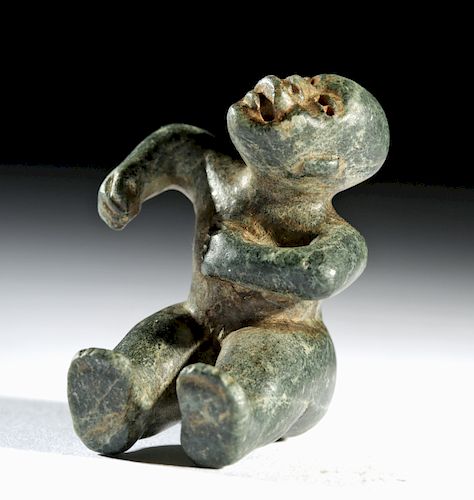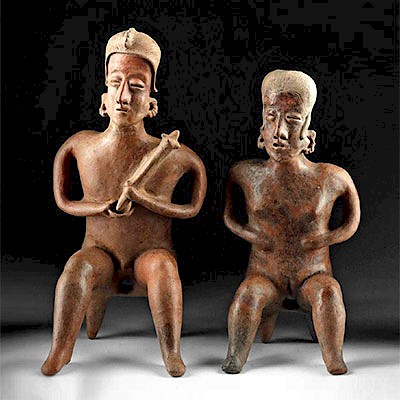Rare & Remarkable Miniature Olmec Jade Figure
Lot 102a
About Seller
Artemis Fine Arts
686 S Taylor Ave, Ste 106
Louisville, CO 80027
United States
Selling antiquities, ancient and ethnographic art online since 1993, Artemis Gallery specializes in Classical Antiquities (Egyptian, Greek, Roman, Near Eastern), Asian, Pre-Columbian, African / Tribal / Oceanographic art. Our extensive inventory includes pottery, stone, metal, wood, glass and textil...Read more
Estimate:
$4,000 - $6,000
Absentee vs Live bid
Two ways to bid:
- Leave a max absentee bid and the platform will bid on your behalf up to your maximum bid during the live auction.
- Bid live during the auction and your bids will be submitted real-time to the auctioneer.
Bid Increments
| Price | Bid Increment |
|---|---|
| $0 | $25 |
| $300 | $50 |
| $1,000 | $100 |
| $2,000 | $250 |
| $5,000 | $500 |
| $10,000 | $1,000 |
| $20,000 | $2,500 |
| $50,000 | $5,000 |
| $100,000 | $10,000 |
| $200,000 | $20,000 |
About Auction
By Artemis Fine Arts
May 23, 2019
Set Reminder
2019-05-23 10:00:00
2019-05-23 10:00:00
America/New_York
Bidsquare
Bidsquare : Exceptional Day 2 Ethnographic Tribal Fossils
https://www.bidsquare.com/auctions/artemis-gallery/exceptional-day-2-ethnographic-tribal-fossils-4136
Day 2 of an important 2-day auction featuring exceptional ethnographic art from around the world. Today's sale will feature Pre-Columbian from the ancient americas, Native American, African / Tribal, Oceanic, Spanish Colonial, and incredible Fossils. Artemis Fine Arts info@artemisfinearts.com
Day 2 of an important 2-day auction featuring exceptional ethnographic art from around the world. Today's sale will feature Pre-Columbian from the ancient americas, Native American, African / Tribal, Oceanic, Spanish Colonial, and incredible Fossils. Artemis Fine Arts info@artemisfinearts.com
- Lot Description
Pre-Columbian, Southern Mexico to Guatemala, Olmec, ca. 900 to 500 BCE. An exquisite, finely-carved blue-green jade, miniature Olmec Baby, seated with legs extended and head cocked so as to look upward toward the celestial realm. The figure gestures expressively with the left arm bent and left hand placed over his chest, and the right arm also bent at the elbow, only the forearm and hand are raised outward from the body. Hallmark Olmec features on the characteristically elongated head include drilled almond-shaped eyes with double pupils, a naturalistic nose, an open mouth with upturned lips characteristic of were-jaguars, and tab-shaped ears. The jowly visage is of a recognizable "baby face" presentation, and the elongated head is a figural depiction of ritualistic cranial deformation. The attention to detail on this piece is rather impressive. Note the expressive lips, clefted palette of the jaguar mouth, and the full nose with flared nostrils, as well as the delineated fingers and toes. A superb sculptural work from the Olmec, replete with sumptuous colors and expert artistry! Size: 1.125" H (2.9 cm)
Research in the late 1990s and early 2000s pinpointed the source of what is colloquially referred to as "Olmec blue" jadeite in the lowland Motagua River near the modern-day border of Guatemala and Honduras; stone from this source was carved and traded widely throughout early Mesoamerica. The value of jade for ancient people lay in its symbolic power: perhaps its color was associated with water and vegetation; later, the Maya would place jade beads in the mouths of the dead. Many scholars have argued that the demand for jadeite contributed to the rise of long-distance trading networks and to the rise of urban centers in ancient Mesoamerica. This would have been an exceedingly valuable and rare jadeite figure.
The Olmec are the ancestors of all Mesoamerican civilizations, and their artistic style, practiced in the tropical lowlands of south-central Mexico and diffused outward through extensive trade networks that stretched into northern Mexico and central America, were inspirational for those who came after. As the first major civilization in this fertile area, scholars believe that Olmec artwork was revered by later civilizations that kept pieces as heirlooms. The Olmec style is famous for its anthropomorphic depictions and became synonymous with elite status in the highlands. They created enormous stone heads, probably the first thing many people think of when remembering the Olmec, but they also made handheld figures like this one as personal totems or divinities created for display in homes or certain types of temples.
Provenance: private West Palm Beach, Florida, USA collection, ex-Worham collection
All items legal to buy/sell under U.S. Statute covering cultural patrimony Code 2600, CHAPTER 14, and are guaranteed to be as described or your money back.
A Certificate of Authenticity will accompany all winning bids.
We ship worldwide and handle all shipping in-house for your convenience.
#146064Slight surface wear commensurate with age. Red deposits in recessed areas of eyes and mouth. Jadeite itself shows beautiful inclusions. Generally intact and excellent.Condition
- Shipping Info
-
All shipping is handled in-house for your convenience. Your invoice from Artemis Gallery will include shipping calculation instructions. If in doubt, please inquire BEFORE bidding for estimated shipping costs for individual items.
-
- Buyer's Premium



 EUR
EUR CAD
CAD AUD
AUD GBP
GBP MXN
MXN HKD
HKD CNY
CNY MYR
MYR SEK
SEK SGD
SGD CHF
CHF THB
THB
















